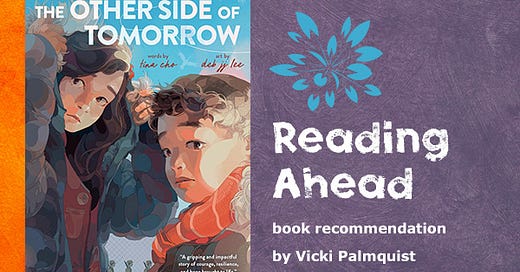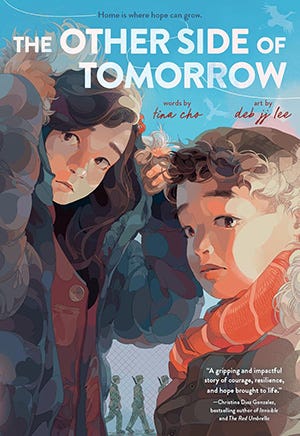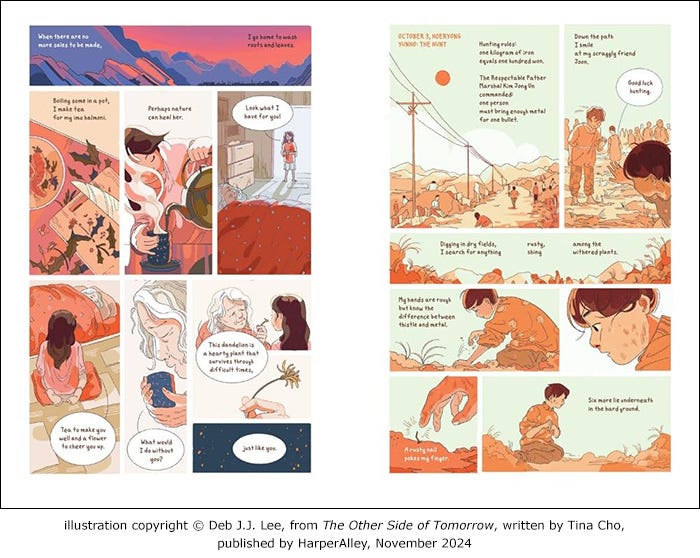I was born during the Korean War and I watched M*A*S*H, but I confess I know very little about the Japanese invasion of Korea or the resulting division of a people’s homeland into North Korea and South Korea in 1948.
Although I read When My Name Was Keoko, by Linda Sue Park, which is set in Korea during the Japanese occupation before World War II, I didn’t research the history after finishing that book. With hindsight, I should have. I focused on the characters’ stories rather than the history in which they were set. I vow to learn more. I’d like to think I’m older and wiser.
Reading The Other Side of Tomorrow raised my awareness of the people and events in North Korea in such a way that I know I must learn more by reading more widely about this divided country.
With a number of deft details, Cho helps us understand (and Lee helps us see) how many North Koreans live in poverty, have lost so many family members, experience famine, and are taught to revere the generalissimo as god in charge of their country. The book is set in 2013, so this is a modern story.
The Other Side of Tomorrow is a story of resilience, grit, and harrowing efforts to escape. It is the story of two children who do not know each other as the story begins: 10-year-old Yunho, a boy whose mother has fled to China and whose grandmother needs care, and 11-year-old Myunghee, a girl whose great-aunt, the only family she has left, is ailing. Her imo halmoni needs nutrition but there is so little food that Myunghee feels helpless.
Neither child is in school. Myunghee sells vegetables on the street as she can. Yunho seeks out discarded metal he can sell. This is how they support their families.
I believe this is a book I will read several times, understanding more with each reading. It is not difficult to read, but there is a lot of meaning and emotion provided by both the author and artist. I want to notice and savor their storytelling.
This is a graphic novel. Lee’s attention to color, the detail in each scene, the expressions on the faces of the main characters, supporting cast, and bystanders is exquisite.
Their color palette is primarily soft orange, coral, rust, green, light blue, and beige. Muted, quiet, without joy.
As happier times occur, memories and dreams are portrayed with brighter colors. By the end of the book, the color palette is full of light and bold tones. The reader cannot help but be affected by this.
Together, the text and art tell a powerful story. Readers who favor traditional prose novels over graphic novels often complain that they are confused about following the story from frame to frame. Where do they go next? For them, that experience jumbles the story, making them feel less confident. They avoid graphic novels.
There is none of that uncertainty here. The frames are laid out in a flowing, easy-to-discern progression that enhances the storytelling. I look forward to future books from Lee.
As the story progresses, each child has an opportunity to flee to China. They must leave friends, the only home they’ve ever known, facing a terrifying future. Yet, they are so unhappy where they are, always hungry, always under the eyes of the ever-present soldiers.
This is the story of their journey to freedom. They meet eventually and travel together. Theirs is not a clear or easy path. The tensions in this tale are plentiful, which makes it a story I couldn’t put down. I read this all in one sitting, ignoring everything going on around me.
It is also a story about the helpers, those who risk their lives to usher escapees to a better life. These are true heroes, the Asian Underground Railroad.
Historical notes in the back matter give us facts about North Korean history and the number of people who have escaped tyranny and totalitarianism.
I am grateful to the author and artist for sharing this outstanding story rooted in reality.
I encourage you to read this book, to place it in the hands of readers old and young.
And I will never buy a string of Christmas lights without looking to see where it comes from.
Do read this interview with author Tina Cho.
The Other Side of Tomorrow
written by Tina Cho
art by Deb J.J. Lee
Harper Alley, November 2024
224 pages
ages 10 and up
Thank you for subscribing to my weekly book recommendation. Many of the books are written for children and teens but I firmly believe adults will enjoy them, too. I review books written for adults, too. I was a precocious reader as a child: I read many books published for adults. It goes both ways. The subscription is free. You can always upgrade to a paid subscription, which encourages me to produce more content. We intend to bring interviews, videos, and podcasts to our paid subscribers in 2025.







This review definitely made me want to read The Other Side of Tomorrow! My depth of understanding about the war doesn't go very deep, either, even though my father was a Korean War-era veteran. The story sounds harrowing, but stories are my favorite way of learning.
I agree with everything Pat said, especially about stories being my favorite way of learning. It's another book I will request from my library.